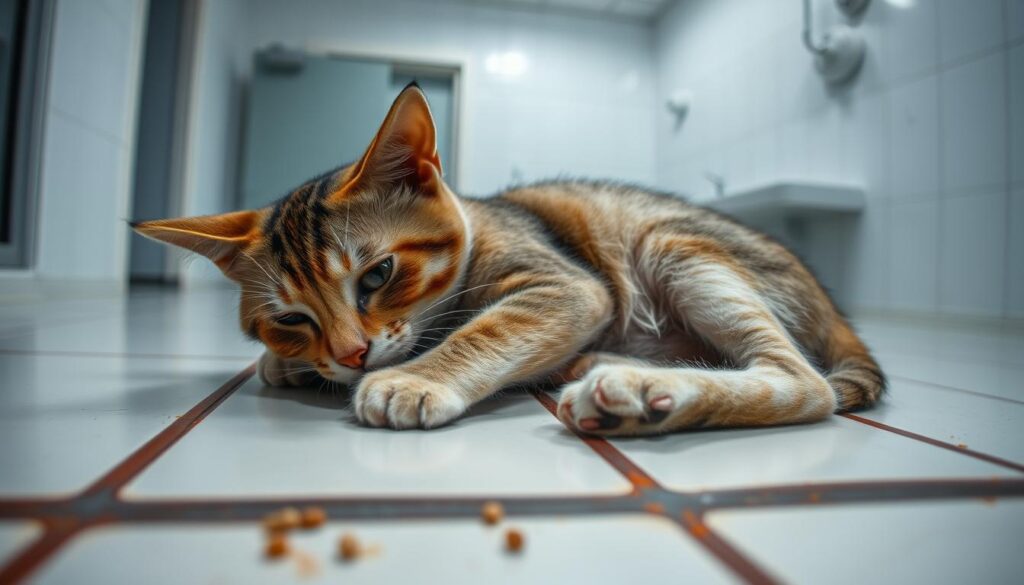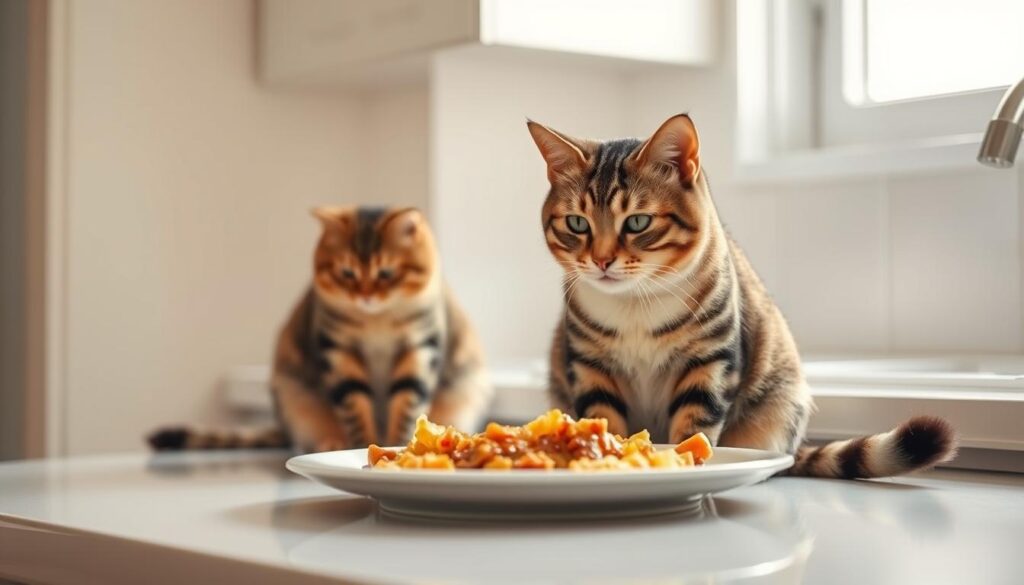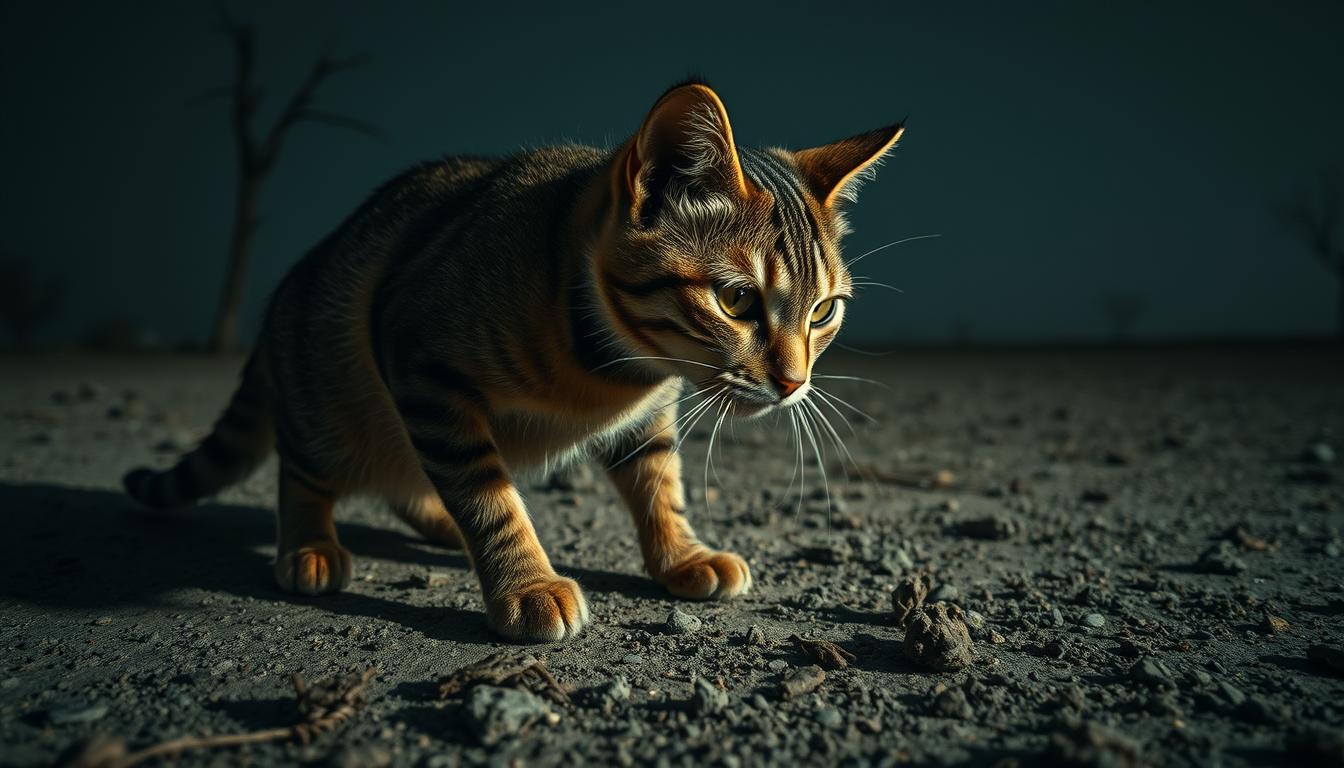Imagine your cat skips a meal and you panic. How long can cats go without food before it’s dangerous? The truth is urgent. Cats might survive 1–2 weeks without food, but health risks start sooner.
After just 24 hours, their bodies start burning fat. This can damage their liver. For kittens or sick cats, the window is even shorter.
Every cat parent’s nightmare is seeing their pet refuse food. But knowing the facts could save their life. A cat’s body isn’t built to fast like ours.
Without food, dehydration hits fast, and their organs strain. Even a single skipped meal matters most for young or older cats, who need immediate care.
Key Takeaways
- Cats face severe health risks after 3–4 days without food, even if they might survive up to two weeks.
- After 24 hours without eating, cats risk liver damage as fat metabolism begins.
- Kittens need vet help within a day of not eating; seniors face similar urgency.
- Water and food are linked—cats get most of their hydration from meals.
- Dr. Welch advises twice-daily feeding to avoid fasting risks.
The Importance of Regular Feeding for Cats
Cats need regular meals to stay healthy. They can’t handle long cat fasting duration without getting sick. Even short times without food can harm them.
Wild cats hunt often, and domestic cats have the same instinct. Skipping meals messes with their digestion and energy.
Normal Feline Eating Patterns
Wild cats eat small prey all day. Your indoor cat does the same. They like 4–6 small meals a day.
This keeps their metabolism going and stops hunger stress.
Why Food Consistency Matters for Cats
Cats love routine. Changes in when or what they eat can upset their stomach. Their bodies are very sensitive.
Stress from irregular meals can make them lose their appetite. Always have fresh water next to their food.
Caloric Needs Based on Cat Size and Age
A 10-pound adult cat needs 250–350 calories every day. This number changes based on how active they are and their health:
- Adults: 25–35 calories per pound
- Kittens: More frequent meals with higher calorie density
- Seniors: Reduced calories (e.g., 200 kcal/day for a 10-pound cat prone to obesity)
Spayed/neutered cats might need 10–20% fewer calories than intact ones. Too many treats (over 10% of daily calories) can make them fat. A UC Davis study found 41% of 9,062 cats were obese, showing the need for careful portion control.
If your cat goes without food for more than 24 hours, see a vet. Quick action can prevent serious problems like liver damage. Stick to a regular feeding schedule to keep your cat healthy for a long time.
How Long Can Cats Go Without Food: The Hard Facts
Knowing the kitty not eating timeline is key for cat owners. Healthy adult cats can go 1–2 weeks without eating if they have water. But, their health drops fast after 24 hours. After one day, their bodies start using fat for energy, which can lead to serious health issues like hepatic lipidosis.
Survival Timeline for Healthy Adult Cats
A cat’s health gets worse quickly, even in the best conditions. Within 24–48 hours without food, their organs struggle to turn fat into energy. By day three, liver damage becomes a big risk. After four days, seeing a vet is crucial. Always watch the cat food abstinence period closely—starvation becomes too late after five days.
Different Timeframes for Kittens and Senior Cats
Kittens are at higher risk. Missing just one meal can lead to hypoglycemia, needing quick care. Senior cats, especially those with health issues like kidney disease, can only go 48 hours without food before organ failure risks increase. Their weakened bodies can’t handle long cat food abstinence periods safely.
The Critical Role of Water vs. Food
- Cats can survive longer without food than without water—dehydration can kill in 2–3 days without fluids.
- Wet food gives 70–80% of a cat’s hydration needs. Dry food alone isn’t enough during reduced intake.
- Signs of dehydration: dry gums, lethargy, sunken eyes.
Don’t think your cat’s “fast” is harmless. Watch for changes in appetite and see a vet if they stop eating for more than 24 hours. Time is crucial in the kitty not eating timeline—acting fast can save lives.
Understanding the Feline Metabolism
Your cat’s body needs a diet rich in protein, unlike humans or dogs. They can’t easily switch to fasting. When feline food deprivation happens, their body goes into survival mode. This can lead to serious health issues.
- Cats can’t break down fat well, causing liver problems in just 24 hours without food.
- They need daily nutrients like taurine and arginine. Without them, damage can be permanent.
- Overweight cats are at higher risk of liver damage during fasting periods.
The starving cat timeframe gets shorter with age or health issues. Kittens under 6 months can get hypoglycemia after 12 hours without food. Adult cats start breaking down muscle for energy after 24 hours, weakening them.
Over time, this can lead to liver failure and organ damage. Look out for signs like lethargy or jaundice. These mean your cat needs urgent vet care.
If your cat misses a meal, watch for changes. Call a vet after 24 hours without food or water. Maine Coons and other breeds need regular meals to stay healthy. Always choose protein-rich diets for their special needs.
Dangerous Health Complications from Food Deprivation
When cats don’t eat, their bodies go into survival mode. This can lead to serious health problems. Knowing how long cats can survive without food is key. Every hour without food increases their health risks.

- Hepatic Lipidosis: Cats start breaking down fat reserves within 24 hours of fasting. This fat can flood the liver, causing fatty liver disease. Overweight cats are at higher risk, showing symptoms like jaundice and vomiting in days.
- Muscle Loss: Without protein, muscles break down to fuel the body. This leads to weakness and lethargy, especially in older cats.
- Immune Breakdown: Starvation weakens defenses, making cats more prone to infections. Wounds heal slower, and recovery takes longer.
- Organ Failure: Extended fasting can permanently damage kidneys, heart, and liver. Damage may remain even after eating resumes.
After 2 days without food, the risk of liver disease increases. Kittens and seniors are most at risk. Missing just one meal can be an emergency. If your cat hasn’t eaten in 24 hours, call a vet right away. Early action can prevent life-threatening conditions like hepatic lipidosis, which develops within 3-4 days of starvation. Always watch your cat’s eating habits to avoid these dangers.
Warning Signs Your Cat Has Gone Too Long Without Eating
When your cat skips meals, time is crucial. Watch for signs during the hungry cat survival period. Look for lethargy, as your cat sleeps more or ignores toys. Also, check for dry gums, sunken eyes, or skin that stays tented when pinched. These are signs of dehydration linked to cat fasting duration.
Visible weight loss is a fast sign. Look for a bony frame or ribs sticking out. Jaundice—yellow eyes or gums—means liver stress. Severe cases may show weakness, drooling, or collapse. Behavioral shifts like hiding, aggression, or excessive meowing signal distress.
- 1-2 days without food: Risk of life-threatening complications rises sharply. Overweight cats are especially vulnerable to hepatic lipidosis.
- Over 24 hours without eating: Vet consultation is critical. Kittens need care after just one missed meal.
- Signs of pain: Refusal to move, panting, or hunched posture may indicate illness.
If your cat shows these signs, act fast. Even a hungry cat survival period shorter than 48 hours needs vet care. Always track when your cat last ate and note any behavioral changes. Early intervention saves lives.
Common Reasons Why Cats Stop Eating
Knowing the kitty not eating timeline is crucial. Cats can live without food for 1–2 weeks. But, health problems can start in just 2–3 days. Understanding how long can cats go without food helps you act fast.

Medical Issues That Affect Appetite
Cats may stop eating due to hidden health struggles:
- Dental pain: Fractured teeth, gingivitis, or oral infections make chewing unbearable.
- Internal issues: Gastrointestinal blockages, kidney disease, or pancreatitis disrupt digestion.
- Systemic illness: Upper respiratory infections reduce smell, a key appetite driver, while diabetes or cancer drain energy.
Environmental and Stress Factors
Even subtle changes can disrupt eating:
- Noise from construction or loud appliances stresses cats, triggering appetite loss.
- New pets, visitors, or rearranged furniture disrupt their routines.
- Litter box proximity to food bowls causes avoidance—cats avoid eating near waste areas.
Food-Related Problems
Cats are picky about meals:
- Texture or taste changes: New flavors, cold leftovers, or stale dry food after 2 months may be rejected.
- Allergies: Ingredients like corn or fillers in low-quality brands can cause vomiting or refusal.
- Portions: Overfeeding at one meal can make cats skip subsequent meals.
Watch your cat’s eating habits closely. If they skip meals for 24 hours, see a vet. This can prevent hepatic lipidosis, a serious condition. Keep their food fresh, their environment stable, and schedule regular vet visits to keep them healthy.
When to Seek Immediate Veterinary Care
When your cat stops eating, time is crucial. The starving cat timeframe starts after just 24 hours without food. Kittens and sick cats need help even faster. Waiting can lead to serious problems like liver failure or dehydration. Here’s how to act quickly:
Emergency Symptoms That Shouldn’t Wait
- No food intake for 24–48 hours (12 hours for kittens)
- Vomiting, diarrhea, or labored breathing
- Weakness, trembling, or extreme lethargy
- Jaundice (yellowish gums/eyes) or sunken eyes
- Loss of coordination or seizures
| Cat Type | Maximum Safe Time Without Food | Risk Factors |
|---|---|---|
| Kittens (under 6 months) | 12–24 hours | Weak immune systems, rapid dehydration |
| Adult Cats | 24–48 hours | Hepatic lipidosis risk after 2 days |
| Sick/ Senior Cats | 24 hours or less | Pre-existing conditions worsen quickly |
What to Tell Your Veterinarian
Prepare this info for your vet:
- Last time your cat ate/drank
- Recent diet changes or new symptoms
- Medications or supplements given
- Exposure to toxins or accidents
Possible Treatments for Non-Eating Cats
Vets may use:
- Fluid therapy for dehydration
- Appetite stimulants or anti-nausea meds
- Feeding tubes for prolonged fasting
- Diagnostic tests (bloodwork, X-rays) to find underlying issues
If your cat shows any emergency signs, don’t wait for office hours. Many clinics offer 24/7 emergency care for critical cases.
Early action saves lives. Hepatic lipidosis can develop in 1–2 days of no food, but timely intervention improves outcomes. Never delay care when your cat skips meals—act before health declines further.
Effective Strategies to Encourage a Reluctant Cat to Eat
If your cat hasn’t eaten for over 24 hours, you must act fast. Not eating for too long can lead to serious health issues, like liver problems in just 3-4 days. Here are some safe ways to help your cat eat again:
- Warm food to release aromas—heat wet food to 98°F to mimic prey’s body temperature.
- Offer high-protein options like tuna juice (not the fish itself) or low-sodium broth for temporary flavor boosts.
- Rotate protein sources weekly to combat food boredom, but avoid mixing multiple foods at once.
Adjust the feeding environment:
- Use ceramic bowls with wide, shallow bases to reduce whisker stress.
- Place food bowls away from litter boxes and in quiet zones to reduce stress.
- Try elevated feeding stations for arthritic cats.
| Method | How It Works | Considerations |
|---|---|---|
| Food Puzzles | Encourages mental stimulation and gradual eating. | Choose puzzles rated for cats weighing under 10 lbs. |
| Hand-Feeding | Builds trust and allows controlled intake. | Only use for short-term encouragement; avoid force-feeding. |
| Microchip Feeders | Limits access to stressed cats while ensuring safe intake. | Invest in models like the SureFeed® Microchip Pet Feeder ($199). |
If your cat still won’t eat after 24 hours, call your vet right away. In severe cases, your vet might prescribe special food or even hospitalize your cat. Always follow your vet’s advice to avoid serious health problems from not eating enough.
Conclusion: Prioritizing Your Cat’s Nutritional Health
Knowing about the cat food abstinence period is key for your cat’s health. A healthy adult cat can go 1-2 weeks without eating. But, they face serious risks in just 24-48 hours without food.
Sudden loss of appetite can lead to liver failure or muscle wasting. So, it’s crucial to get vet care quickly. Senior cats need special diets with easy-to-digest proteins and controlled calories.
Watch their food intake closely, especially in homes with multiple cats. Keep 100% pumpkin puree ready for emergencies. Avoid giving them toxic foods like grapes or onions.
Wet food helps keep them hydrated, while dry food is good for their teeth if they drink enough water. Always talk to a vet before changing their diet or if they stop eating. Regular vet visits and consistent feeding schedules help prevent problems and keep your cat healthy for a long time.
FAQ
How long can cats go without food?
What are the signs that my cat is hungry or needs to eat?
Why is regular feeding important for my cat?
What should I do if my cat hasn’t eaten for a day?
What health risks are associated with food deprivation in cats?
What factors influence how long my cat can go without food?
How can I encourage my cat to eat if they are reluctant?
What should I tell my veterinarian if my cat won’t eat?
Can stress affect my cat’s appetite?
How does water intake affect a cat’s ability to go without food?
Source Links
- How Long Can Cats Go Without Food? – Essential Guide – https://michupet.com/blogs/pet-care/how-long-can-cats-go-without-food?srsltid=AfmBOooxYSJTUFk8gpTnfqiA0o5tUfMRSt3aU8aGqU_NehVLyLpyYIqW
- How Long Cats Can Go Without Food And When To Be Concerned, According To A Vet – https://www.southernliving.com/food/how-to/how-long-can-a-cat-go-without-eating?srsltid=AfmBOorY2V3vlQPbTVBKyM7oB59xEWVib3RRE88hvCB1AXL9gGxBboQ4
- How Much To Feed a Cat – https://www.petmd.com/cat/nutrition/how-much-to-feed-a-cat
- How Long Can Cats Go Without Food? Understanding Feline Survival Needs – https://michu.com.au/blogs/news/how-long-cats-go-without-food-and-water?srsltid=AfmBOop0KkePsKuiiXdEBrianOZ354ADX4twFHtApl2XUelWJwCI4215
- How Long Can Cats Go Without Food? – Essential Guide – https://michupet.com/blogs/pet-care/how-long-can-cats-go-without-food?srsltid=AfmBOopCXBZCp1spmModZ4x34M3Hh-3FJRoU13hsvbuhyV663cU6AVuL
- How Long Cats Can Go Without Food And When To Be Concerned, According To A Vet – https://www.southernliving.com/food/how-to/how-long-can-a-cat-go-without-eating?srsltid=AfmBOoo692WZ_b3ySeFRyFxOYJ2lNmvASS8V3OE5GksAORfpZmIlnSmu
- Famished Feline Facts: How long Can Cats Go Without Food? – https://www.trustedhousesitters.com/blog/pets/how-long-can-cats-go-without-food/
- How Long Can Cats Go Without Food? – Essential Guide – https://michupet.com/blogs/pet-care/how-long-can-cats-go-without-food?srsltid=AfmBOoqWN2EAveVMGcL9rEQIg9BH1JT3m3ZVDkKLqi8on0NzkwrmxVDh
- How Long Can Cats Go Without Food? Understanding Feline Survival Needs – https://michu.com.au/blogs/news/how-long-cats-go-without-food-and-water?srsltid=AfmBOoomqQieACOixN_uZor6nlVkd_4MBDYHRyWUK4ZYzz5KXkjcIJ24
- How Long Can Maine Coon Cats Go Without Food? – Petzooie – https://www.petzooie.com/articles/how-long-can-maine-coon-cats-go-without-food
- How long can cats go without food? | Blog – https://www.cats.org.uk/cats-blog/how-long-can-cats-go-without-food
- How Long Can Cats Go Without Food? – Essential Guide – https://michupet.com/blogs/pet-care/how-long-can-cats-go-without-food?srsltid=AfmBOoqnDPMGSOFVlS5fkIo4fB_-SzbhgvNhJwbH_pwMmoH2byazO8Dq
- 6 Reasons Why Your Cat Is Not Eating and What To Do – https://www.petmd.com/cat/nutrition/cat-not-eating-what-to-do
- What to do When Your Cat Won’t Eat – https://www.webmd.com/pets/cats/my-cat-wont-eat
- How Long Can Cats Go Without Food? – Essential Guide – https://michupet.com/blogs/pet-care/how-long-can-cats-go-without-food?srsltid=AfmBOooZPgGeivnCfGdtbEKgGGLbhpleN4BLj2SxN11aamtnFrPiBmmK
- 8 Reasons Why Your Cat Is Not Eating – https://www.thesprucepets.com/cat-is-not-eating-4579814
- How Long Can Cats Survive Without Food? – https://basepaws.com/cat-insider/how-long-can-a-cat-go-without-eating?srsltid=AfmBOoqC-Rd8o_kYo2fhb5gUYcdMqCLRr_gIA6ODHjtEKvBT0-Cyn6FK
- How Long Can Cats Go Without Food? – Essential Guide – https://michupet.com/blogs/pet-care/how-long-can-cats-go-without-food?srsltid=AfmBOoov_P2BVoFr1HbcULbhZue4kna7GSxthRi5A4II1p6jxQCbjukk
- How Long Can Cats Go Without Food? – Essential Guide – https://michupet.com/blogs/pet-care/how-long-can-cats-go-without-food?srsltid=AfmBOoqnemvVQgnaaXwp77ZTHiWKa2JkvKOYA8lmAx7jEzbLCkTNXOuk
- How Long Can Cats Go Without Food? Understanding Feline Survival Needs – https://michu.com.au/blogs/news/how-long-cats-go-without-food-and-water?srsltid=AfmBOoo_EqLL2ubHIoAXlGGccb20m12IrsZ6KSOARhut11JPi6c94n08
- When Should a Cat See the Vet [& How to Tell If Your Cat is Sick] – https://www.splootvets.com/post/when-should-a-cat-see-the-vet-signs-cat-is-sick
- How to encourage your cat to eat – https://icatcare.org/articles/how-to-encourage-your-cat-to-eat
- 10 Ways to Get Your Cat to Eat – Modern Cat – https://moderncat.com/articles/10-ways-to-get-your-cat-to-eat/
- Cat Not Eating? 10 Probable Reasons Why – Total Vet – https://total.vet/cat-not-eating/
- Senior Cat Diet: Feeding Your Elderly Cat | Purina UK – https://www.purina.co.uk/articles/cats/senior/health/feeding-your-senior-cat
- Human Foods That Are Safe for Cats (Vet Answer) | PangoVet – https://pangovet.com/pet-nutrition/cats/human-foods-safe-for-cats-vet-answer/
